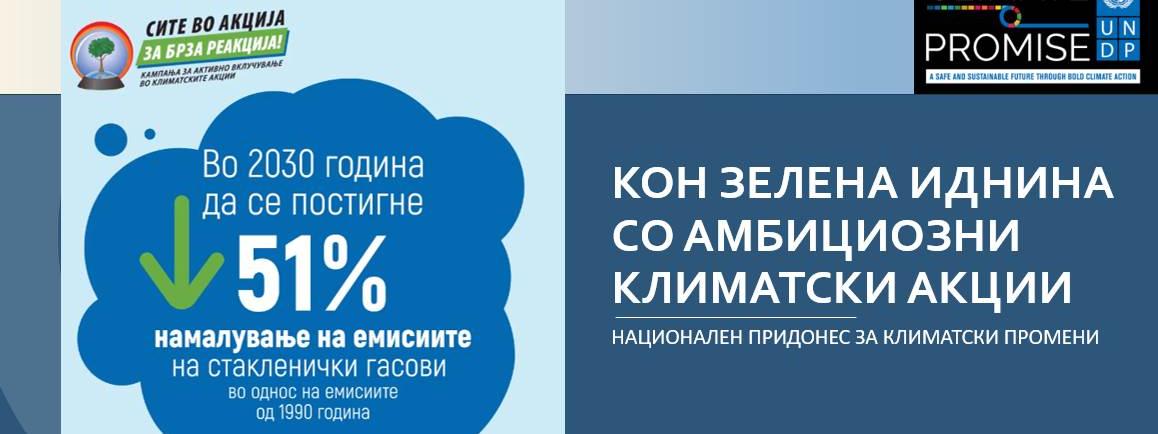6 things you should know about Macedonian climate change policies
Interview with Teodora Obradovikj Grncharovska, UNFCCC Focal Point and Elena Gavrilova Dimitrovska, Deputy Team Leader of the project “Preparation of Long-term Strategy and Law on Climate Action“
This interview covers the institutional framework which is the basis for creating climate policies in North Macedonia, the state of alignment with EU acquis on climate, barriers to transposing and implementing regulation, reporting to the United Nations Convention on Climate change and the status of the National adaptation plan to climate change.

Take a look at 6 important things you should know about the latest Macedonian climate change policies and how they align with UNFCCC and EU Perspectives:
1. Is there a national Climate Strategy and Climate Law? Is it in line with the EU 2030 framework for climate and energy policies?

Elena: The Long term strategy and the Law on Climate Action are in their final stage of preparation. They are envisaged to be adopted by the Macedonian Government at the end of 2021. The Law transposes the MMR Directive and the EU ETS, as well as the relevant provisions from Energy Governance Regulation. In addition, the draft Long term strategy covers adaptation and other cross-cutting policies and measures.
Both documents were built on the assessments made in the other relevant climate change documents (BURs, NCs, NDCs) and are fully in compliance with other strategic and planning documents in energy sector (Energy Strategy and its Program for implementation, Law on Energy, National Energy and Climate Plan).
2. Is there a National Climate Change Adaptation Strategy or Adaptation Action Plan in place?
 Teodora: So far, the adaptation component was covered by the National Communications on Climate Change and other sectoral strategies (health, agriculture and other sectors). The draft Long term strategy on Climate Action considers adaptation aspects too, although these actions have limited scope and are focused on priority adaptation aspects identified in the framework of the Third National Communication on Climate Change
Teodora: So far, the adaptation component was covered by the National Communications on Climate Change and other sectoral strategies (health, agriculture and other sectors). The draft Long term strategy on Climate Action considers adaptation aspects too, although these actions have limited scope and are focused on priority adaptation aspects identified in the framework of the Third National Communication on Climate Change
A proposal for developing an overarching National Adaptation plan shall be submitted to the Green Climate Fund for approval for financing by June 2021. That means that the first Macedonian National Adaptation Plan shall be completed in 2023.
3. Where does the country stands regarding reporting to United Nations Framework Convention on Climate Change (UNFCCC) and implementation of the Paris Agreement?
Teodora: The Republic of North Macedonia (Macedonia), as a Non-Annex I Party to the UNFCCC, has been developing Inventory of the anthropogenic emissions by sources and removals by sinks of GHGs emitted to or removed from the atmosphere for the period 1990-2016 as a part of its National Communications and Biennial Update Reports on Climate Change. By the end of 2021, the time series shall be updated to cover until 2019. The inventory covers five main sectors: Energy, Industrial Processes and Product Use, Agriculture, Forestry and Other Land Use and Waste, disaggregated by categories and subcategories. It includes a database for the following greenhouse gasses: CO2, CH4, N2O, PFCs and HFCs, as well as precursors and indirect emissions from: CO, NOx, NMVOC, SO2 and NH3.
Up to now, three National Communications (2003, 2008 and 2014) and three Biennial Update Reports (2015, 2018 and 2021) have been delivered to the UNFCCC.
The 3rd Biennial Update Report on Climate Change was adopted in April 2021. The preparation of the 4th National Communication on Climate Change has started in 2020 and it is expected to be submitted to the UNFCCC in 2022
The enhanced NDC, adopted in April 2021, echoes the Green scenario from the National Strategy for Energy Development up to 2040 and is fully aligned with the draft National Energy and Climate Plan (NECP). The enhanced NDC is strongly linked with the Long-Term Strategy on Climate Action and the Law on Climate Action. The enhanced NDC is focused on mitigation and envisions the inclusion of the adaptation component in subsequent submissions once relevant national strategic and planning documents are prepared and adopted.
4. What is the status of a National Energy and Climate Plan in line with Energy Community obligations?
Teodora: The draft National Energy and Climate Plan in line with Energy Community obligations is in its final stage of preparation and is based on the green scenario from the Energy Strategy. It should be adopted by the Government in 2021.
5. What is the state of alignment with the following EU climate acquis considerations?
Elena: The following EU regulations have been transposed:
- Regulation (EU) No 525/2013 Monitoring Mechanism Regulation, replaced by Regulation (EU) 2018/1999
R525/2013 is transposed in the Draft Law on Climate Action, in the section devoted to “Mechanism of monitoring and reporting of GHG emissions” as well as in the subsequent secondary legislation based on this Law.
- R2018/1999 is also considered in the Draft Law on Climate Action, in the section devoted to “Basic planning documents for climate action”
Directive 2003/87/EC Emission Trading Scheme (ETS), amended by Directive (EU) 2018/410
The Republic of North Macedonia will participate in the EU ETS with the time of accession. In the accession process the country must prepare for the participation so that it can be effective with accession.
The ETS covers GHG emissions from stationary industrial sources and aviation. Stationary sources must have a GHG emission permit issued by the competent authority, and GHG emissions must be in accordance with given allowances. The Draft Law on Climate Action foresees the requirement for GHG emission permits, the procedure and the competent authority: it proposes the framework for the system and for the monitoring and reporting, as well as accreditation and verification. The framework for ETS will need to be implemented by secondary legislation.
- Directive 2008/101/EC on inclusion of aviation into ETS
For aviation the EU ETS requires from aircraft operators a GHG emission monitoring plan to be approved by authorities. The Draft Law on Climate action proposes the framework for the system and for the monitoring and reporting, as well as accreditation and verification. The framework for ETS will need to be implemented by secondary legislation.
- Regulation 601/2012 on monitoring and reporting of GHG emissions
GHG emissions must be monitored and reported. The Draft Law on Climate action proposes the framework for the system and for the monitoring and reporting, as well as accreditation and verification. The framework for ETS will need to be implemented by secondary legislation. A Monitoring, reporting and Verification platform for climate actions is being developed and should be fully functional and part of the Macedonian National Environmental System in 2022. The legal baseline for the platform are set in the draft Law on Climate Action.
- Regulation 602/2012 on verification of GHG emissions
The Draft Law on Climate action proposes the framework for the system and for the monitoring and reporting, as well as accreditation and verification.
- Decision 406/2009/EC Effort Sharing, complemented by Regulation (EU) 2018/842
The system of effort-sharing between the EU member states in reducing the emissions of GHG is included in the Decision and the Regulation. The system covers GHG emission from sources not covered by the EU ETS, especially from buildings, transport, waste management and agriculture.The requirement is that an EU member state ensures that the target given to it for GHG emission from the sectors covered is complied with. The emissions must be monitored and reported regularly.
For the Republic of North Macedonia, the Regulation will be the legal instrument applicable with the time of accession. In the accession process it is necessary to prepare for the system. Identified needs are: mechanisms for target-setting, arrangements- including institutional arrangements- for ensuring reduction obligations in the various sectors, and arrangements for monitoring and reporting.
The draft Law on Climate action proposes basic provisions for the respective sectors as well as monitoring and reporting obligations, but the reduction obligations shall mostly be achieved through sectoral legislation applicable to the above-mentioned sectors.
- Directive 2009/31/EC Geological storage of CO2
Due to the complication of the process for Carbon Capture and Storage (CCS), as well as the possibility given to Member States to allow or forbid storage sites in their territory (Article 4 par.1), it is important initially to determine whether the storage sites will be forbidden or allowed in the country.
Therefore, the Directive is not considered for transposition by the draft Law on Climate Action. The draft Law on Climate Action proposes a general provision that the Government will decide about the exploration for and use of the CCS. If and when CCS technology (exploration and use) is decided to be allowed in the Republic of North Macedonia, legislative changes will be needed to be in line with the CCS Directive, especially the provisions of the Directive amending a number of other EU Directives.
- Regulation EU/517/2014 F-Gases
F-Gases in the country are partly regulated by the Law on Environment and subsequent secondary legislation. They are partly in compliance with the EU Acquis. The full compliance/transposition of the EU acquis related to F-Gases, at the pre-accession stage should be considered based on the needs and readiness of the country to apply EU requirements. Two follow up options are under consideration:
Option 1: The F-Gases to remain under the Law on Environment; and
Option 2: Regulation of F-Gases in the Law on Climate Action and repealing the Law on Environment provisions.
- Regulation EC/1005/2009 Ozone Depleting Substances (ODS)
ODS in the country are regulated by the Law on environment and subsequent secondary legislations. They are partly in compliance with the EU Acquis (listed in the left).
Two options are under consideration:
Option 1: The ODS to remain under the Law on Environment; and
Option 2: Regulation of ODS in the Law on Climate Action and repealing the Law on Environment provisions.
The full compliance/transposition of the EU acquis related to ODS, at the pre-accession stage should be considered based on the needs and readiness of the country to apply EU requirements.
- Directive 98/70/EC Fuel Quality
The Directive will not be transposed in the draft Law on Climate Action neither in secondary legislation with a legal base in this Law.
The Directive is partly transposed into the national legislation, full transposition is expected to be achieved by adoption of the Decree on quality of liquid fuels and the Law on biofuels.
In the draft Law on Climate Action, will be considered only cross reference provision to the national legislation governing fuel quality.
- Regulation (EU) 2019/631 setting CO2 emission performance standards for new passenger cars and for new light commercial vehicles, and repealing Regulations (EC) No 443/2009 and (EU) No 510/2011
The Regulation will not be transposed in the draft Law on Climate Action, neither in secondary legislation with a legal base in this Law. In the draft Law on Climate Action, only cross reference provision to the national legislation governing vehicles will be considered. The main burden from this Regulation is set for manufacturers of vehicles. For Member states are set few obligations for: monitoring and reporting of average emissions from new passenger cars registered in their territory, and designation of competent bodies/institutions for collection and communication of the monitoring data to the Commission. For this purpose, Article 8 and Annex II from the Regulation should be considered for transposition into the existing national legislation governing vehicles.
- Directive 1999/94/EC Consumer Information
The Directive is fully transposed into the Rulebook for the availability of consumer information on fuel economy and CO2 emission regarding marketing of new passenger cars (Official Gazette 65/2013). Referred Rulebook is adopted based on the Law on vehicles.
- Decision 529/2013/EU LULUCF, completed by Regulation (EU) 2018/841
The EU system of LULUCF is included in the Decision and the Regulation. For the Republic of North Macedonia, this Regulation will be directly applicable with the time of accession.
6. What are the obstacles to the transposition and implementation for transposition, implementation and enforcement, at the national and local level? How is inter-institutional coordination ensured?
Teodora: The understanding behind the proposed Law on Climate Action (LCA) is that it responds to and transposes the current climate acquis and legally binding commitments of the country. It is not intended to anticipate climate action developments which are currently debated at the EU and concern the targets for the coming decades. Legal rules need to be established when the new acquis is established and in accordance with the accession procedure. At that point, additional objectives, approaches and instruments may be possible. The LCA is flexible to react to new forthcoming requirements.
LCA is conceived as a framework law, which means that it provides the basis of climate action and gives orientation; it does not regulate all details or aspects of climate change. The LCA is implemented through secondary legislation, but also through other sectoral legislation, i.e., legislation which covers relevant sectors such as transport, agriculture or waste management, as well as secondary legislation under the sectoral laws. Therefore, climate action in North Macedonia requires a multi-sectoral legislative approach. In addition, the proposed Law on Climate Action gives a legal basis for different policy instruments.
Carbon pricing needs a thorough assessment covering economic, fiscal, social, and other aspects; specific rules must be developed, and the appropriate place for these rules needs to be determined.
The LCA transposes the Emission trading scheme (ETS Directive) to the best extent possible. It provides rules for the GHG emission permit and the obligations for GHG monitoring and reporting by the operators (of industry and aviation). The competence of the Ministry of Environment and Physical Planning is clear in the LCA, also the main procedural rules. Extensive list of additional secondary legislation is foreseen to be developed in the near future in order to fully regulate and enable implementation of the ETS aspects as foreseen under the Draft Law on Climate Action. All these activities are considered in the Draft Action Plan for the First Stage of implementation of the Law. The rules on participation in the emission trading regime are not there yet, as North Macedonia can participate in the trade regime only as an EU Member State. The option to establish a national ETS in the wake of EU accession was not chosen. The option to prepare the country for the participation in the EU ETS was found appropriate and preferred.
The draft Law on Climate Action will ensure legally binding inter-institutional coordination mechanism. Further changes in acts of systematisation in respective institutions will be required.
-
Корисни линкови
26-01-2021 -
Справување со климатските промени и загадувањето на воздухот во градот Скопје
29-04-2018 -
Финансирање во климата
28-01-2022 -
Микронаративи
08-06-2022
{{"article.lastestPosts"|translate}}
-
Нови финансирања за унапредување на природата и биолошката разновидност на Зелената агенда за Западен Балкан
11-03-2025 -
Започна проектот за развој на 1-от и 2-от двогодишен извештај за транспарентност и 5-от национален извештај за климатски промени на С.Македонија
04-03-2025 -
Земјоделски форум за климатски промени: Се изнаоѓаат решенија за поголема климатска отпроност на заемјоделието
02-12-2024 -
Заврши COP29, центарален фокус на финасирањето за климата
02-12-2024



 Мод за знаковен јазик
Мод за знаковен јазик Говорен асистент
Говорен асистент Означи линкови
Означи линкови

 Зголеми маус
Зголеми маус